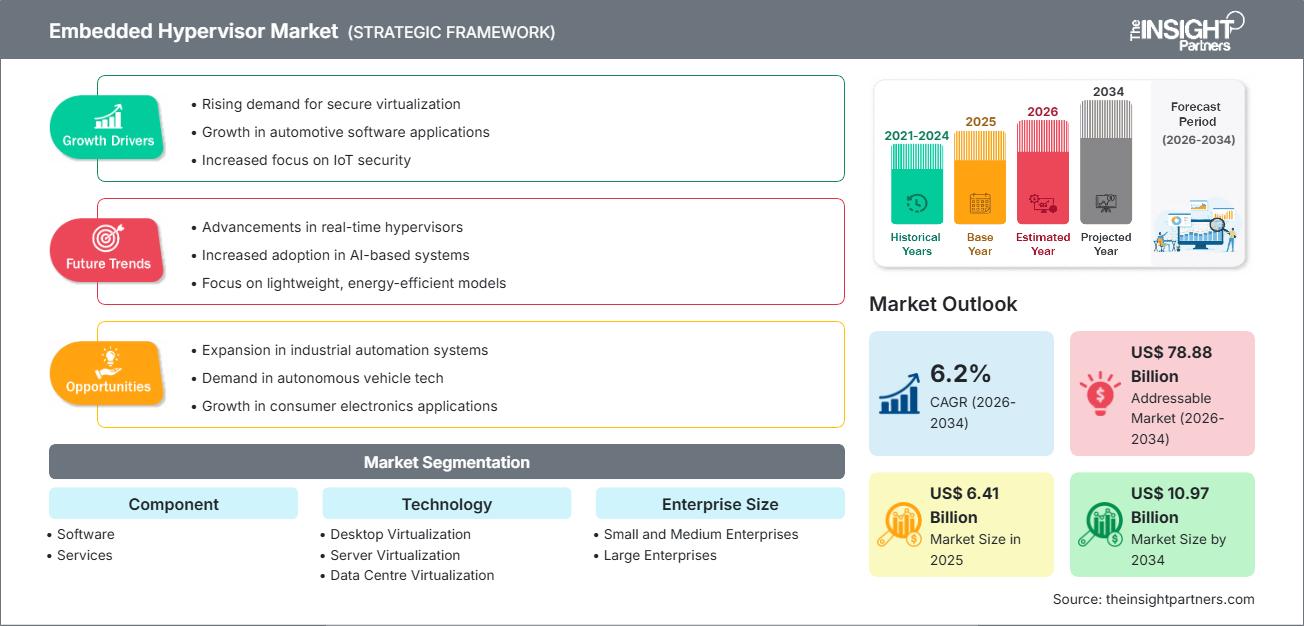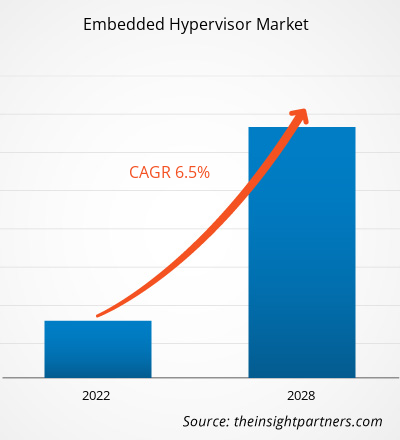임베디드 하이퍼바이저 시장 규모는 2025년 64억 1천만 달러에서 2034년 109억 7천만 달러에 이를 것으로 예상됩니다. 이 시장은 2026년부터 2034년까지 연평균 6.2%의 성장률을 기록할 것으로 전망됩니다.
임베디드 하이퍼바이저 시장 분석
임베디드 하이퍼바이저 시장은 임베디드 시스템이 단일 하드웨어 플랫폼에서 여러 운영 체제를 지원하기 위해 가상화 계층을 점점 더 많이 도입함에 따라 주요 산업 전반에 걸쳐 꾸준히 성장하고 있습니다. 실시간 운영 체제, 자동차 ECU용 가상화, 산업 자동화 및 커넥티드 디바이스와 같은 기술의 활용 확대가 수요를 견인하고 있습니다. 예를 들어, 임베디드 하이퍼바이저는 여러 제어 기능을 통합하고, 안전 필수 인증을 지원하며, 시스템 복잡성을 줄이는 동시에 하드웨어 활용도를 향상시킵니다.
임베디드 하이퍼바이저 시장 개요
임베디드 하이퍼바이저 솔루션은 임베디드 시스템에서 단일 하드웨어 플랫폼 상에 여러 운영 체제 또는 소프트웨어 환경을 동시에 실행할 수 있도록 가상화 계층을 제공합니다. 이러한 기능은 실시간 운영, 안전 필수 제어, 인포테인먼트, 연결성 및 연산 집약적 작업을 결합하는 현대 시스템에서 점점 더 중요해지고 있습니다. 멀티코어 임베디드 프로세서, 엣지 컴퓨팅, IoT, 차량용 ADAS의 성장과 규제/안전 요구 사항의 증가는 임베디드 하이퍼바이저의 도입을 가속화하고 있습니다.
이 보고서를 귀하의 요구사항에 맞게 맞춤 설정하십시오.
모든 보고서에 대한 맞춤형 서비스(본 보고서의 일부 또는 국가별 분석, Excel 데이터 팩 포함)를 무료로 제공해 드립니다. 또한 스타트업 및 대학을 위한 다양한 할인 혜택도 누리실 수 있습니다.
임베디드 하이퍼바이저 시장: 전략적 고찰

-
이 보고서에서 주요 시장 동향을 확인하세요.이 무료 샘플에는 시장 동향부터 추정치 및 예측에 이르기까지 다양한 데이터 분석이 포함됩니다.
임베디드 하이퍼바이저 시장 동인 및 기회
시장 동인:
- 시스템 통합 및 가상화의 증가: 임베디드 시스템이 발전함에 따라, 더 적은 하드웨어 자원으로 여러 기능을 통합하고, ECU 수를 줄이며, 비용 효율성을 향상시키기 위해 가상화에 대한 필요성이 점점 커지고 있습니다.
- 안전, 보안 및 실시간 요구 사항: 더욱 엄격해진 안전 및 사이버 보안 요구 사항과 실시간 결정론적 동작에 대한 필요성으로 인해 기능을 격리하고 여러 운영 체제를 지원할 수 있는 임베디드 하이퍼바이저에 대한 수요가 증가하고 있습니다.
- IoT, 엣지 컴퓨팅, 멀티코어 임베디드 프로세서의 성장: IoT 기기의 확산, 엣지 컴퓨팅 구축, 이기종 멀티코어 임베디드 시스템의 증가는 임베디드 환경에서 가상화 계층에 대한 수요를 창출하고 있습니다.
시장 기회:
- 자동차 및 자율주행 차량: 소프트웨어 정의 차량(SDV)으로의 전환, 전동화 증가, 첨단 운전자 보조 시스템(ADAS)은 임베디드 하이퍼바이저 사용에 큰 기회를 창출하여 여러 ECU를 통합하고 다양한 중요도의 기능을 구현할 수 있도록 합니다.
- 산업 자동화 및 IIoT: 스마트 공장, 로봇 공학 및 연결된 산업 시스템은 유연하고 안전하며 효율적인 임베디드 컴퓨팅을 위해 가상화가 필요하며, 이는 하이퍼바이저 솔루션 공급업체에게 기회를 제공합니다.
- 통신 및 5G/엣지 인프라: 5G/6G 네트워크와 엣지 컴퓨팅 구축이 확대됨에 따라 임베디드 하이퍼바이저는 네트워크 기능 가상화, 보안 파티셔닝 및 실시간 임베디드 네트워킹 작업을 지원할 수 있습니다.
임베디드 하이퍼바이저 시장 보고서 세분화 분석
임베디드 하이퍼바이저 시장 점유율은 시장 구조, 성장 잠재력 및 새로운 트렌드를 보다 명확하게 이해하기 위해 다양한 부문에 걸쳐 분석됩니다. 아래는 대부분의 산업 보고서에서 사용되는 표준적인 시장 세분화 방식입니다.
구성 요소별:
- 소프트웨어: 내장 하이퍼바이저 소프트웨어는 장치 내 가상화를 지원하여 여러 운영 체제가 공유 하드웨어에서 안전하고 효율적으로 실행될 수 있도록 합니다.
- 서비스: 서비스에는 임베디드 하이퍼바이저 솔루션의 최적 배포, 성능 및 규정 준수를 보장하기 위한 통합, 유지 관리, 컨설팅 및 맞춤 설정이 포함됩니다.
기술별 분류:
- 데스크톱 가상화: 임베디드 또는 산업용 데스크톱에서 여러 운영 환경을 격리하고 관리할 수 있도록 하여 유연성, 보안 및 리소스 활용도를 향상시킵니다.
- 서버 가상화: 임베디드 서버 워크로드를 더 적은 수의 물리적 시스템으로 통합하여 성능을 최적화하고 비용을 절감하며 미션 크리티컬 애플리케이션의 확장성을 향상시킵니다.
- 데이터 센터 가상화: 데이터 센터에 하이퍼바이저 기술을 통합하여 가상 머신을 관리하고, 내장된 워크로드를 간소화하며, 실시간으로 확장 가능한 인프라를 지원합니다.
기업 규모별:
- 중소기업(SME)은 하드웨어 비용을 절감하고 유연성을 향상시키며 제한된 인프라에서 안전한 다중 애플리케이션 사용을 가능하게 하기 위해 임베디드 하이퍼바이저를 도입합니다.
- 대기업: 대규모 조직은 복잡하고 안전에 중요한 고성능 임베디드 시스템 전반에 걸쳐 시스템 통합, 데이터 보안 강화 및 규정 준수를 위해 임베디드 하이퍼바이저를 활용합니다.
산업별:
- BFSI
- IT 및 통신
- 항공우주 및 방위산업
- 자동차
- 의료 서비스
- 운송
지리학별:
- 북아메리카
- 유럽
- 아시아태평양
- 남미 및 중앙아메리카
- 중동 및 아프리카
임베디드 하이퍼바이저 시장 지역별 분석
인사이트 파트너스의 분석가들은 예측 기간 동안 임베디드 하이퍼바이저 시장에 영향을 미치는 지역별 트렌드와 요인들을 자세히 설명했습니다. 이 섹션에서는 북미, 유럽, 아시아 태평양, 중동 및 아프리카, 남미 및 중앙아메리카를 아우르는 임베디드 하이퍼바이저 시장 세분화 및 지역별 분석도 다룹니다.
임베디드 하이퍼바이저 시장 보고서 범위
| 보고서 속성 | 세부 |
|---|---|
| 2025년 시장 규모 | 64억 1천만 달러 |
| 2034년 시장 규모 | 109억 7천만 달러 |
| 글로벌 연평균 성장률(2026년~2034년) | 6.2% |
| 역사적 데이터 | 2021-2024 |
| 예측 기간 | 2026-2034 |
| 포함되는 부문 |
구성 요소별
|
| 대상 지역 및 국가 |
북아메리카
|
| 시장 선도 기업 및 주요 기업 프로필 |
|
임베디드 하이퍼바이저 시장 참여자 밀도: 비즈니스 역학에 미치는 영향 이해
임베디드 하이퍼바이저 시장은 소비자 선호도 변화, 기술 발전, 제품 이점 인식 제고 등 여러 요인으로 인한 최종 사용자 수요 증가에 힘입어 빠르게 성장하고 있습니다. 수요가 증가함에 따라 기업들은 제품군을 확장하고, 소비자 요구를 충족하기 위한 혁신을 추진하며, 새로운 트렌드를 활용하여 시장 성장을 더욱 촉진하고 있습니다.

- 임베디드 하이퍼바이저 시장의 주요 기업 개요를 확인하세요.
임베디드 하이퍼바이저 시장 점유율 분석 (지역별)
북미는 임베디드 하이퍼바이저 시장에서 가장 큰 점유율을 차지하고 있으며, 예측 기간 동안에도 이러한 지배력을 유지할 것으로 예상됩니다. 아시아 태평양 지역은 가장 빠르게 성장하는 지역 시장입니다. 중국, 일본, 한국, 인도와 같은 국가들은 자동차 전자 장치, 소비자 기기 및 스마트 제조 분야의 급속한 발전으로 인해 임베디드 하이퍼바이저 도입을 주도하고 있습니다.
임베디드 하이퍼바이저 시장은 임베디드 시스템의 가상화, 자동차 및 산업 자동화 부문의 성장, 안전 필수 임베디드 플랫폼에 대한 투자 등 여러 요인으로 인해 지역별로 서로 다른 성장 궤적을 보이고 있습니다. 아래는 지역별 시장 점유율 및 동향에 대한 요약입니다.
1. 북미
- 시장 점유율: 북미는 자동차, 항공우주/방위산업, 산업 자동화 분야의 강세와 첨단 임베디드 시스템 도입에 힘입어 여러 조사에서 임베디드 하이퍼바이저 시장을 선도하고 있습니다.
- 주요 동인: 임베디드 시스템에 대한 높은 투자, 첨단 제조, 견고한 기술 생태계, 안전 및 보안에 대한 수요.
- 주요 동향: 자동차 분야에서 다양한 중요도의 워크로드를 처리하기 위한 임베디드 하이퍼바이저 도입, ECU 통합, 엣지 컴퓨팅 구축.
2. 유럽
- 시장 점유율: 유럽은 자동차 제조, 방위 시스템 및 산업 자동화 덕분에 강력한 시장입니다.
- 주요 동인: 엄격한 안전 및 규제 기준(기능 안전, 사이버 보안), 강력한 자동차 및 항공우주 산업, 산업용 IoT 사업.
- 동향: 인증된 안전 애플리케이션에 임베디드 하이퍼바이저 사용 증가, 가상화된 임베디드 플랫폼으로의 전환, EU의 디지털 전환 투자 확대.
3. 아시아 태평양
- 시장 점유율: 아시아 태평양 지역은 중국, 인도, 일본 및 동남아시아의 도입에 힘입어 가장 빠르게 성장하는 지역으로 자주 언급됩니다.
- 주요 동인: 급속한 산업화, 자동차 및 전자제품 제조업의 성장, 스마트 기기/사물인터넷(IoT)의 등장, 정부의 지원 프로그램.
- 주요 동향: 자동차 및 산업용 임베디드 시스템에서 가상화 기술의 확산, 멀티코어 임베디드 프로세싱에 대한 높은 수요, 그리고 솔루션의 현지화 추세.
4. 남미 및 중앙아메리카
- 시장 점유율: 임베디드 하이퍼바이저 도입률이 중간 수준이지만, 산업계의 디지털/임베디드 시스템 업그레이드에 따라 성장 잠재력이 있는 신흥 시장입니다.
- 주요 동인: 자동차 제조 성장, 산업 설비 개선, 임베디드 시스템 현대화에 대한 투자 증가.
- 동향: 비용 효율적인 가상화 솔루션 도입, 임베디드 소프트웨어 플랫폼 분야의 글로벌 벤더와의 파트너십 확대.
5. 중동 및 아프리카
- 시장 점유율: 잠재력이 있는 또 다른 신흥 지역이지만, 현재 도입률은 선진 지역에 비해 낮습니다.
- 주요 동인: 스마트 인프라 투자, 항공우주 및 방위산업 현대화, 공공시설 및 산업 부문에서의 사물인터넷(IoT) 도입.
- 동향: 보안 임베디드 플랫폼에 대한 관심이 증가하고 있지만, 도입 속도가 느리고 인프라 성숙도가 낮아 성장이 제한적입니다.
임베디드 하이퍼바이저 시장 참여자 밀도: 비즈니스 역학에 미치는 영향 이해
임베디드 하이퍼바이저 시장은 주요 글로벌 기술 제공업체와 신흥 틈새 시장 업체 및 전문 스타트업의 존재로 인해 경쟁이 심화되고 있습니다. 기업들은 시장 지위를 강화하고 다양한 산업 분야에서 지능형 의사결정 플랫폼에 대한 증가하는 수요를 충족하기 위해 적극적으로 혁신하고 있습니다.
치열한 경쟁 환경으로 인해 공급업체들은 다음과 같은 방식으로 차별화를 꾀하고 있습니다.
- 세계적인 기술 기업 및 임베디드 소프트웨어 공급업체들이 임베디드 시스템을 위한 가상화/하이퍼바이저 기능을 제공하고자 합니다.
- 자동차, 항공우주 및 산업 분야에 특화된 하이퍼바이저 솔루션을 제공하고 기능 안전 인증을 획득한 전문 틈새 시장 업체입니다.
- 통합 및 파트너십: 벤더들은 통합 가상화 플랫폼을 제공하기 위해 임베디드 OS 제공업체, 멀티코어 프로세서 벤더 및 시스템 통합업체와 점점 더 많이 협력하고 있습니다.
- 주요 공급업체들은 혼합 중요도 파티셔닝, 안전 인증, 실시간 성능, 하드웨어 지원(마이크로컨트롤러/멀티코어) 및 서비스/통합과 같은 기능에 중점을 둡니다.
기회와 전략적 움직임
- 임베디드 시스템 통합업체와 OEM 업체들은 하이퍼바이저 기술을 활용하여 통합 플랫폼을 제공함으로써 비용, 무게 및 복잡성을 줄이고 있으며, 이는 하이퍼바이저 공급업체들에게 전략적 기회를 열어주고 있습니다.
- 소프트웨어 정의 차량(SDV)의 등장으로 자동차 분야의 임베디드 하이퍼바이저 수요가 급증할 것으로 예상됩니다.
- 항공우주, 방위 및 산업 자동화 분야에서 안전하고 격리된 가상화된 임베디드 워크로드에 대한 중요성이 점점 커짐에 따라 하이퍼바이저 솔루션의 성장 가능성이 더욱 높아지고 있습니다.
임베디드 하이퍼바이저 시장에서 활동하는 주요 기업은 다음과 같습니다.
- 시트릭스 시스템즈 주식회사
- IBM 주식회사
- 마이크로소프트 주식회사
- VMware 주식회사
- 윈드 리버 시스템즈 주식회사
- NXP 반도체
- 탈레스 그룹
- Fent 혁신 소프트웨어 솔루션, SL
- 링스 소프트웨어 테크놀로지스
- 지멘스 AG
면책 조항: 위에 나열된 회사들은 특정 순서대로 순위가 매겨진 것이 아닙니다.
임베디드 하이퍼바이저 시장 뉴스 및 최근 동향
- 예를 들어, IBM은 2025년 10월 27일 금융 기관, 정부 및 기업이 디지털 자산 운영을 안전하게 관리하고 확장할 수 있는 종합 플랫폼인 IBM 디지털 자산 헤이븐(IBM Digital Asset Haven)을 출시한다고 발표했습니다. 이제 은행과 정부는 보관부터 거래, 결제에 이르기까지 디지털 자산의 전체 수명 주기를 관리할 수 있는 단일 솔루션을 통해 규정 준수 의무를 이행하는 동시에 다른 시스템과의 통합도 용이하게 할 수 있습니다.
- 2025년 3월 11일, 임베디드 월드(EMBEDDED WORLD)는 자동차 시장의 혁신적인 솔루션 분야에서 신뢰받는 파트너인 NXP Semiconductors NV가 자동차 업계 최초로 임베디드 자기 RAM(MRAM)을 탑재한 16nm FinFET MCU인 새로운 S32K5 자동차용 마이크로컨트롤러(MCU) 제품군을 공개했습니다. S32K5 MCU 제품군은 NXP CoreRide 플랫폼에 사전 통합된 구역 제어 및 전동화 시스템 솔루션을 제공하여 확장 가능한 소프트웨어 정의 차량(SDV) 아키텍처를 구현할 수 있도록 지원합니다.
임베디드 하이퍼바이저 시장 보고서 범위 및 제공 내용
"임베디드 하이퍼바이저 시장 규모 및 전망(2021~2034)" 보고서는 다음과 같은 영역을 포함하여 시장에 대한 자세한 분석을 제공합니다.
- 본 보고서의 범위에 포함된 모든 주요 시장 부문에 대한 글로벌, 지역 및 국가 수준의 임베디드 하이퍼바이저 시장 규모 및 전망
- 임베디드 하이퍼바이저 시장 동향과 함께 시장 동인, 제약 요인, 주요 기회 등의 시장 역학을 분석합니다.
- 상세한 PEST 및 SWOT 분석
- 임베디드 하이퍼바이저 시장 분석은 주요 시장 동향, 글로벌 및 지역별 시장 환경, 주요 업체, 규제 및 최근 시장 발전을 다룹니다.
- 임베디드 하이퍼바이저 시장의 시장 집중도, 히트맵 분석, 주요 업체 및 최근 개발 동향을 포함한 산업 환경 및 경쟁 분석. 상세한 기업 프로필 제공
- 과거 분석(2년), 기준 연도, CAGR을 포함한 예측(7년)
- PEST 및 SWOT 분석
- 시장 규모 가치/거래량 - 글로벌, 지역, 국가
- 산업 및 경쟁 환경
- Excel 데이터세트
최근 보고서
사용 후기
구매 이유
- 정보에 기반한 의사 결정
- 시장 역학 이해
- 경쟁 분석
- 고객 인사이트
- 시장 예측
- 위험 완화
- 전략 기획
- 투자 타당성 분석
- 신흥 시장 파악
- 마케팅 전략 강화
- 운영 효율성 향상
- 규제 동향에 발맞춰 대응






















 무료 샘플 받기 - 임베디드 하이퍼바이저 시장
무료 샘플 받기 - 임베디드 하이퍼바이저 시장